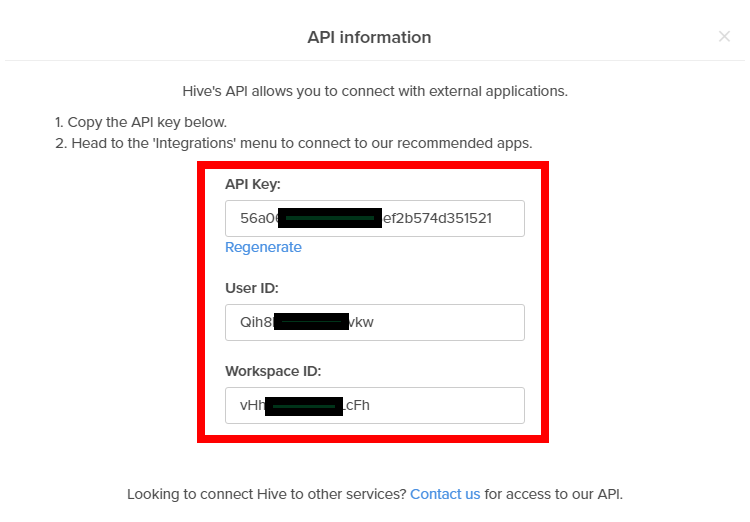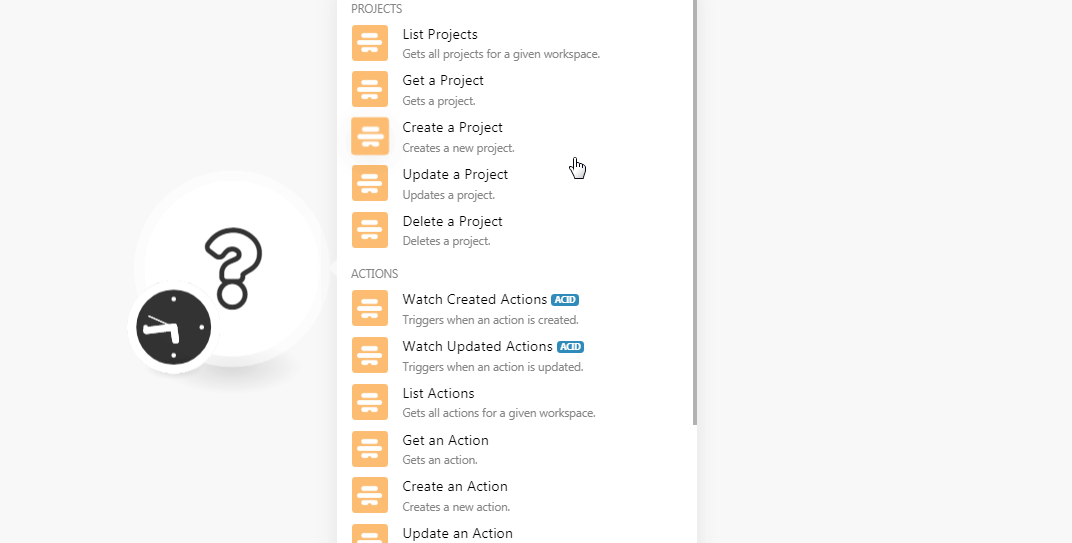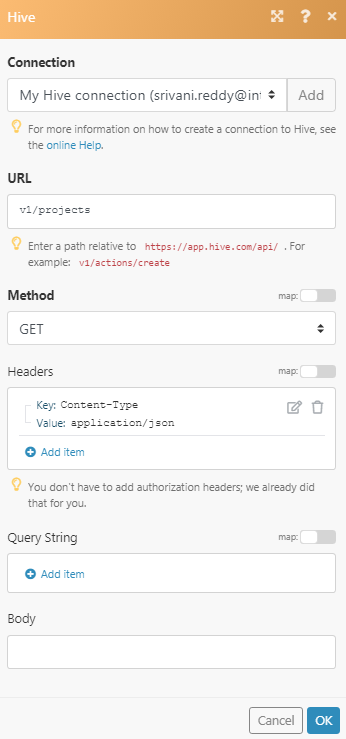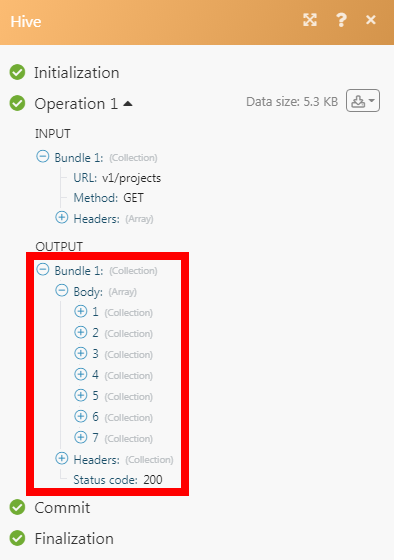The Hive modules allow you to watch, create, update, retrieve, list, and delete the projects, actions, and messages in your Hive account.
Prerequisites
-
A Hive account
In order to use Hive with Boost.space Integrator, it is necessary to have a Hive account. If you do not have one, you can create a Hive account at app.hive.com/join.
To connect your Hive account to Boost.space Integrator you need to obtain the API Key and User ID from your Hive account and insert it in the Create a connection dialog in the Boost.space Integrator module.
1. Log in to your Hive account and open your Dashboard.
2. Click Your Profile Icon > API information.

3. Copy the API Key and User ID details to a safe place.

4. Go to Boost.space Integrator and open the Hive module’s Create a connection dialog.

5. In the Connection name field, enter a name for the connection.
6. In the API Key and User ID fields, enter the API key and user ID details copied in step 3 and click Continue.
The connection has been established.
Gets all projects for a given workspace.
|
Connection |
|
|
Workspace ID |
Select the Workspace ID whose projects you want to list. |
|
Limit |
Set the maximum number of projects Boost.space Integrator should return during one scenario execution cycle. |
Gets a project.
|
Connection |
|
|
Workspace ID |
Select the Workspace ID whose project details you want to retrieve. |
|
Project ID |
Select the Project ID whose details you want to retrieve. |
Creates a new project.
|
Connection |
|
|
Workspace ID |
Select the Workspace ID whose project details you want to retrieve. |
|
Name |
Enter a name for the project. |
|
Description |
Enter the details of the project. |
|
Start Date |
Enter the date when the project begins. |
|
End Date |
Enter the date when the project must complete. |
|
Sharing Type |
Select the project sharing type:
|
|
Members |
Add the User ID of the members with whom you want to share the project details. |
|
Teams |
Add the Team ID with whom you want to share the project details. |
|
Project Custom Fields |
Add the custom fields for the project. Unique ID Enter the field value. For example, the Label Enter a label for the custom field. Value Enter the value for the custom field. |
|
Color |
(Optional) Enter the hex code of the color you want to give for the project. |
|
Template |
Select whether you want to give a template for the project. |
|
Copy From |
Select the option to copy the template. For example, |
|
Copy Action Statuses |
Select whether to copy the action status of the project. |
|
Copy Assignees |
Select whether to copy the assignees. |
|
Access Option |
Select the project access:
|
|
Phases |
Add the phases for the project. For example, |
Updates a project.
|
Connection |
|
|
Workspace ID |
Select the Workspace ID whose project details you want to update. |
|
Project ID |
Select the Project ID whose details you want to update. |
|
Name |
Enter a name for the project. |
|
Description |
Enter the details of the project. |
|
Start Date |
Enter the date when the project begins. |
|
End Date |
Enter the date when the project must complete. |
|
Color |
(Optional) Enter the hex code of the color you want to give for the project. For example, for the |
|
Access Option |
Select the project access:
|
Deletes a project.
|
Connection |
|
|
Workspace ID |
Select the Workspace ID whose project details you want to delete. |
|
Project ID |
Select the Project ID you want to delete. |
Triggers when an action is created.
|
Connection |
|
|
Workspace ID |
Select the Workspace ID whose action details you want to watch. |
|
Limit |
Set the maximum number of new actions Boost.space Integrator should return during one scenario execution cycle. |
Triggers when an action is updated.
|
Connection |
|
|
Workspace ID |
Select the Workspace ID whose action details you want to watch. |
|
Limit |
Set the maximum number of updated actions Boost.space Integrator should return during one scenario execution cycle. |
Gets all actions for a given workspace.
|
Connection |
|
|
Workspace ID |
Select the Workspace ID whose action details you want to watch. |
|
Limit |
Set the maximum number of actions Boost.space Integrator should return during one scenario execution cycle. |
|
Project ID |
Select the Project ID whose actions you want to list. |
|
Sort Order |
Select the order to list the actions:
|
|
Object |
Select the object to list the actions. For example, |
|
Field Name |
Select the option to filter the actions you want to list. For example, |
|
Value |
Select a value for the filter. For example, |
Gets an action.
|
Connection |
|
|
Workspace ID |
Select the Workspace ID whose action details you want to watch. |
|
Action ID |
Select the Action ID whose details you want to retrieve. For example, |
Creates a new action.
|
Connection |
|
|
Workspace ID |
Select the Workspace ID in which you want to create the action. |
|
Title |
Enter a name for the action. |
|
Description |
Enter the details of the action. |
|
Assignees |
Add the User IDs of the assignees for the action. |
|
Project ID |
Enter the Project ID to which the action belongs to. |
|
Deadline |
Enter the date by when the action must be complete. |
|
Scheduled Date |
Enter the date when the action is scheduled to perform. |
|
Process ID |
Select the Process ID (action Template ID) to apply as an action template. |
|
Custom Fields |
Label Enter a label for the action. Value Enter the value for the action field. |
Updates an action.
|
Connection |
|
|
Workspace ID |
Select the Workspace ID in which you want to create the action. |
|
Action ID |
Select the Action ID whose details you want to update. |
|
Title |
Enter a name for the action. |
|
Status |
Enter the status of the action. |
|
Update Children |
Select whether to update the children. |
|
Urgent |
Select whether this action is urgent. |
|
Privacy |
Select the action access:
|
|
Checked |
Select whether this action is checked. |
|
Parent |
Select the parent action if this action is a subaction. |
|
Description |
Enter the details of the action. |
|
Assignees |
Add the assignees to whom you want to assign the action. |
|
Label Name |
Add the labels for the action. |
|
Deadline |
Enter the date by when the action must be complete. |
|
Scheduled Date |
Enter the date when the action is scheduled to perform. |
|
Custom Fields |
Add the custom fields for the action: LabelEnter a label for the custom field. ValueEnter the value for the custom field. |
|
Shift Subactions Deadline |
Select whether this action has shift subaction deadline. |
Deletes an action.
|
Connection |
|
|
Workspace ID |
Select the Workspace ID whose action details you want to delete. |
|
Action ID |
Select the Action ID you want to delete. |
Creates a new message.
|
Connection |
|
|
Workspace ID |
Select the Workspace ID in which you want to create the message. |
|
Body |
Enter the message text. |
|
Container ID |
Select the Container ID (group) in which the message will be created. |
|
Sender First Name |
Enter the sender’s first name. |
|
Sender Picture |
Enter the URL address to the sender’s picture. |
|
Color |
(Optional) Select the background color of the message. |
Performs an arbitrary authorized API call.
|
Connection |
|
|
URL |
Enter a path relative to For the list of available endpoints, refer to the developers.hive.com/reference. |
|
Method |
Select the HTTP method you want to use: GET to retrieve information for an entry. POST to create a new entry. PUT to update/replace an existing entry. PATCH to make a partial entry update. DELETE to delete an entry. |
|
Headers |
Enter the desired request headers. You don’t have to add authorization headers; we already did that for you. |
|
Query String |
Enter the request query string. |
|
Body |
Enter the body content for your API call. |

